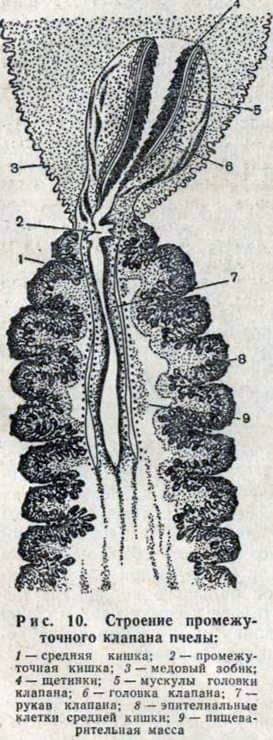
In most plants, pollen and nectar are formed in one flower. The volatile, easily dispersed pollen in the air inevitably, sometimes in large quantities, falls into the nectar and is taken away by the bee. Honey with a lot of pollen is unsuitable for wintering bees. Nutrients of pollen grains at a low temperature in the nest are not absorbed by bees and are useless. In addition, the pollen grains accumulating in the hind gut of the bees significantly increase the mass of feces that overload the gut (the bees do not excrete the feces in the winter and are released from it only in the spring during the first flying). A specially conducted experiment on the application of honey for honey bees with an increased admixture of pollen showed that bees, feeding on such honey, get diarrhea and die. Therefore, cleaning nectar from excessive pollen is essential for the successful wintering of bees.
Purified nectar from excessive pollen during its stay in honey crab, in the intermediate gut, connecting zobik with the middle gut.
The intermediate gut (valve) of the bee consists of a head inside the honey crab, from which the tube-tube leaving the honey crab and penetrating into the anterior end of the mid-gut moves away.

The valve head is a round muscular hollow formation, consisting of four blades. On the inner side of each blade there are chitinous spinules with sharp edges turned inwards. As soon as the honey croup is filled with liquid, the head blades begin to make exciting movements, opening and closing the cracks between them. When the blades are compressed, the liquid part of the feed, passed between the spinules, pours back into the honey cind, and the solid particles (dust grains) with a small amount of liquid linger in the head and then move through the sleeve to the mid-gut. Such exciting movements and fluid filtration continue uninterruptedly throughout the time that honey beetles are filled with nectar or ripening honey. This leads to a gradual purification of nectar from excess pollen,
The hose of the intermediate intestine forms a thin, long tube with soft elastic walls inside the midgut. Such a structure of the sleeve excludes the possibility of moving food in the opposite direction – from the mid-gut to the honey cind.
Due to the continuous operation of the valve, the bee can not completely give away all the nectar or honey taken in the honey cind. Part of it (pollen grains along with a part of the liquid) always passes into the mid-gut and is consumed by the bee’s food, i. e. The valve also performs the function of controlling the feeding of the bee.
Как замачивать шкуры. Что за хищные пчелы.
Feeding base of beekeeping